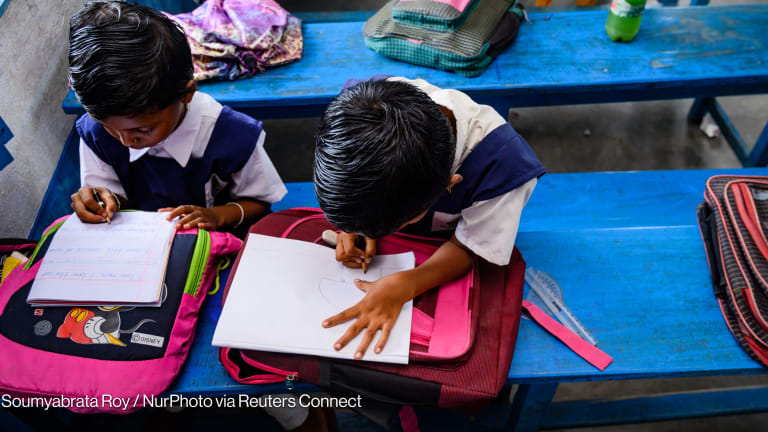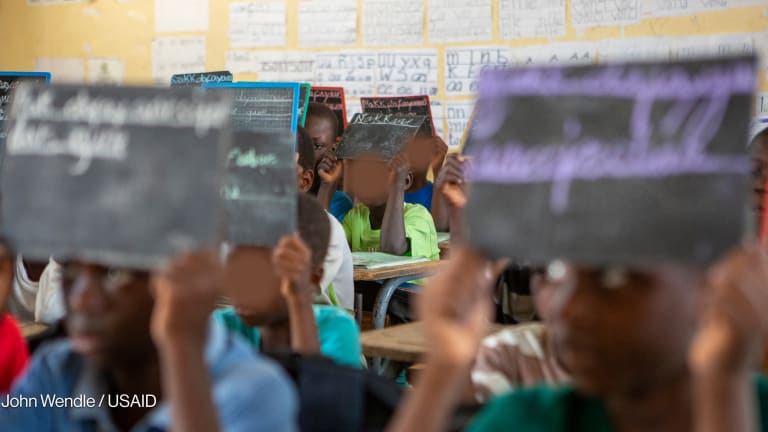
BARCELONA — Last week, the Lego Foundation announced a $100 million investment into play-based learning initiatives for children impacted by crises. Teaming up with a consortium led by the International Rescue Committee, the PlayMatters partnership aims to reach 1 million children, teachers, and caregivers living in Ethiopia and Uganda.
“Learning through play is about hands-on, minds-on learning,” said Sarah Bouchie, head of global programs at the Lego Foundation, adding that the approach can benefit children who have experienced conflict by helping them work through trauma and develop emotional, cognitive, social, creative, and physical skills.
“We know from kids themselves that participating in play activities helps [them] to process really difficult feelings that they have had around their situations.”
— Sarah Bouchie, head of global programs, Lego FoundationLaunched ahead of this week’s Global Refugee Forum, this is the Lego Foundation’s third significant investment into education in conflict settings within a year: The foundation awarded a $100 million grant to Sesame Workshop in December 2018 and a $12.5 million grant to Education Cannot Wait in September 2019.
Not everyone is convinced by learning through play as a method, however. Some say it can lack substance and requires significant guidance from teachers to be effective, which might not be practical in an emergency setting.
Speaking to Devex, Bouchie responded to doubts about the value of learning through play and explained why the foundation is investing so heavily right now.
The conversation has been edited for length and clarity.
How does learning through play work in practice?
In Colombia, we are working with a partner in a variety of settings … with the idea that you bring children into a classroom and you provoke learning opportunities to give them a chance to think. For example, you would set out magnifying glasses and a watermelon — a portion of it has been sitting out for several days. You give kids the tools to take a look and a journal to record what they're doing. They put on a little lab coat so that they can pretend to be investigators. That gives them a chance to discover how basic biology works, but also to pretend, to engage in symbolic play, to really think differently and be motivated by their learning experience.
With a partner in India, we did something where the school janitor had to carry a number of different tools with him and he wasn't as efficient as he could be. The children had to define the problem, think of solutions, create those solutions, and test them. As they did that, there was computational thinking and mathematics. It was planning, iterations, practical examples that could make them feel like they were doing something to help somebody who helps them every day. It's just shifting the way that you think about how you introduce math or language in writing skills instead of rote memorization.
Are there benefits of learning through play specifically for refugee children?
Yes. What we know as “play” is really the most natural way for children to learn and develop holistic skills. We also know that learning through play provides comfort, helps children to overcome traumatic experiences, [and] builds resilience. Importantly, it means a return to routine and the normalcy of being a child.
“That's part of what we want to instill: How can you use what's around you in order to enable a great learning experience?”
— Sarah Bouchie, head of global programs, Lego FoundationWhat [refugee children] need in order to help their brains develop normally is a consistent adult in their lives, a focus on core life skills like executive function and inhibitory control — the kinds of things that help them regulate their emotions in an appropriate context with their developmental age — and reduced stress. Play does all of those things. We know from kids themselves that participating in play activities helps [them] to process really difficult feelings that they have had around their situations.
Over the past year, the Lego Foundation has made three substantial investments into learning in humanitarian settings, with a focus on learning through play. Why now?
Our board has been thinking about it for a long time and, for a number of reasons, we have increased our giving. We feel like we're in a position to really help make some change happen in the world and there is a focus in particular on conflict-affected settings, because there has been a call for more actors to come into this space. Part of what we can do as a private sector actor is to set an example and help to inspire others to [come forward].
What's exciting about this newest grant with the IRC is that we're putting a lot of focus on the problem that we're trying to solve and not being married to a set of solutions, but testing and iterating solutions over time so that we can come up with the best way to [create] really great learning environments.
There are some who criticize play-based learning as just being play. What would your response be to that?
We certainly think that free play is important and really good for kids. The foundation has seen from its research, as well as the partnerships that we've had with others, that when you bring a playful approach, it helps to innovate the way classroom environments engage children and motivate teachers. That can give us a [launchpad to explore]: How do you move beyond basic fulfillment to giving high-quality education that thinks about multiple skills that are really important for children? Literacy and numeracy are absolutely important, but also creativity and problem-solving and looking for more engaging, collaborative ways of learning.
So should learning through play be supplemented with the more traditional teaching methods?
I wouldn't say that. I think, in every context, you figure out how it is that children respond best. Individualized learning is about understanding how an individual child responds. That's the kind of environment that we want [for] teachers … putting this into their toolbox and thinking about how to use engaging opportunities to give different children what they need.
Does it always require having props like Legos?
No. Teaching and learning materials are definitely important, but what we've seen from a myriad of our investments is that can be locally created and made. Most of the programs that we fund don't have Duplo or Lego bricks. If it's appropriate, absolutely — we think that Lego bricks are some of the greatest play materials in the world and if it can be helpful, then we would add them, but if it's disruptive, then we shouldn't. Some great toys have been created from recycled things. That's part of what we want to instill: How can you use what's around you in order to enable a great learning experience?
Three in one year — can we expect more big announcements?
It's important that we're making momentum. If and when we can see that the Lego Foundation can be a catalyst for other activity, we will step into [that] space.








